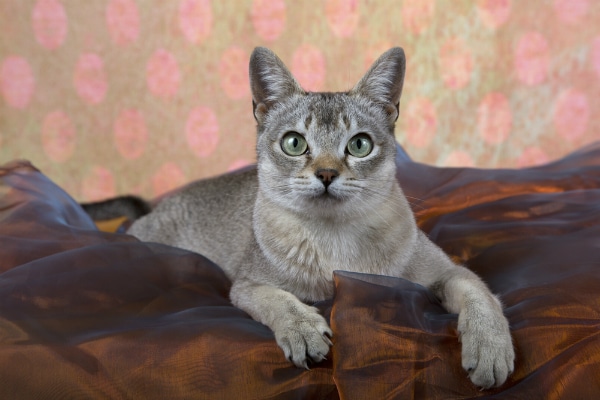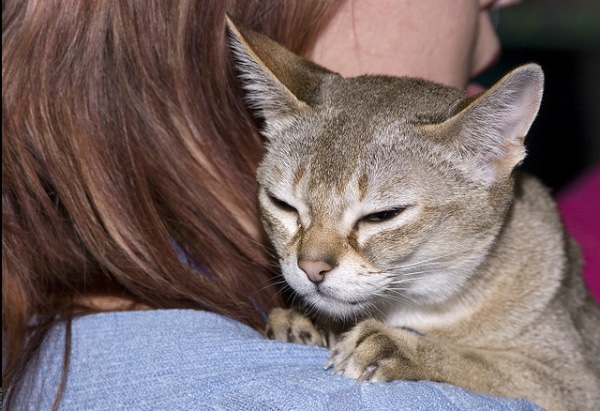When you first meet this tiny cat with a ticked tabby coat, you may mistake her for an Abyssinian kitten, but she’s not: she’s a Singapura, a natural breed in her own right, plucked from the streets of Singapore and occupying homes all over the world.

Origins
In 1975, geophysicist Hal Meadow and his wife Tommy returned to the U.S. from a four-year stint in Singapore with five cats with brown-ticked fur. They said they found these cats in the streets of Singapore and used them as a foundation for a new breed that they called the Singapura. In 1980, breeder Barbara Gilbertson visited Singapore and found another brown-ticked cat in the SPCA shelter. She imported that cat to the U.S. and he was adopted into the Singapura breeding program.
Controversy about the breed arose in 1987 after breeder Gerry Mayes went to Singapore on a cat-finding trip and ended up finding importation papers indicating that the Meadows had brought the Singapura foundation cats from the U.S. to Singapore in 1974. The Cat Fanciers’ Association launched an investigation and found that there was no wrongdoing, and thus decided to keep the Singapura’s status as a natural breed.

Appearance
The Singapura is thought to be the smallest of cat breeds, with adult females weighing in at five to six pounds and adult males weighing six to eight pounds. Singapuras don’t reach their full size until they’re about two years old.
Singapuras’ eyes are yellow, hazel or green and are relatively large in proportion to the head. They only come in one color: rich sable brown ticking over an ivory-colored undercoat, fading to a pale beige color on the belly. They often sport gorgeous natural “eyeliner” and a line of dark pigment around the edge of the nose leather.
Health and longevity
Singapuras have an average life expectancy of between 12 and 15 years, and generally live those years in good health. However, there are a couple of conditions that plague some lines of Singapuras. The first of these is uterine inertia: Breeding females may not be able to continue labor long enough to push out their kittens, and thus they require Caesarian section delivery. The other is pyruvate kinase deficiency, a metabolic disorder leading to a lack of an enzyme required to create healthy red blood cells. This deficiency can lead to hemolytic anemia, in which red blood cells break down and are unable to carry oxygen to the body’s tissues.

What it’s like to live with a Singapura
You know that kid who never stops moving, and you wish you could bottle some of that energy for yourself? The Singapura is like that kid. She’s incredibly intelligent, active, energetic, outgoing, and always in the mood for a good play session. She’s also super-affectionate and is more than willing to “help” you with any chores or work you have to do, and once she’s done playing, she’ll gladly snuggle with you while you sleep or watch movies.
Your Singapura loves high places, so be sure to have plenty of cat trees, shelves, and other avenues for her to satisfy her desire to climb and scratch. She’ll easily make friends because she’ll always have that innocent “Hi! I’m a kitten!” expression, which will melt the hearts of every person and pet she meets.
Singapura trivia bits
- The Singapore Tourist and Promotion Board uses the Singapura as a tourist mascot. There, the cat is called a Kucinta, an amalgamation of the Malay words kucing (cat) and cinta (love).
- A 2007 DNA study determined that there are very few genetic differences between the Singapura and the Burmese, which may support the assertion that it is not a natural breed.
- The Singapura is 31st in popularity among the 41 breeds recognized for championship by the Cat Fanciers’ Association.

Do you have a Singapura? What is it like to live with her? Please share your thoughts and Singapura photos in the comments.
Read more on cat breeds:
- Get to Know the Maine Coon: A Gentle Giant Bred by Nature
- Get to Know the Manx: A Mighty Hunter and Sweet Companion
- Meet the Tonkinese: The “Perma-Kitten” With a Heart of Gold
- Get to Know the Nebelung: The Cat of the Mists
- Get to Know the American Shorthair: One of America’s Original Cats
- Why Cat Breeds Like the Bengal, Savannah and Chausie Have No Business Being Banned
- Meet the Sphynx, the Official Cat Breed of National Nude Day
- Meet the Lykoi, Better Known as the Werewolf Cat
- In Honor of Colonel Meow: 6 Long-Haired Cat Breeds I Love
- A Grand Tour of Scottish Fold Kittens
Learn more about your cat with Catster:
- I’m Willing to Bet That Your Cat Hates Her Litter Box — Here’s Why
- Weird Cat Facts: 8 Reasons Your Cat Likes to Lick You
- Our Best Tips for Getting Your Cat to Let You Sleep
About JaneA Kelley: Punk-rock cat mom, science nerd, animal shelter volunteer and all-around geek with a passion for bad puns, intelligent conversation, and role-play adventure games. She gratefully and gracefully accepts her status as chief cat slave for her family of feline bloggers, who have been writing their award-winning cat advice blog, Paws and Effect, since 2003.







